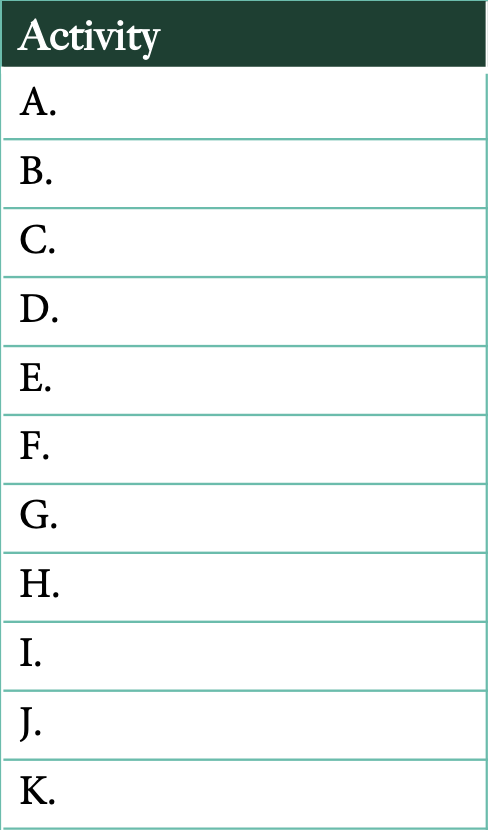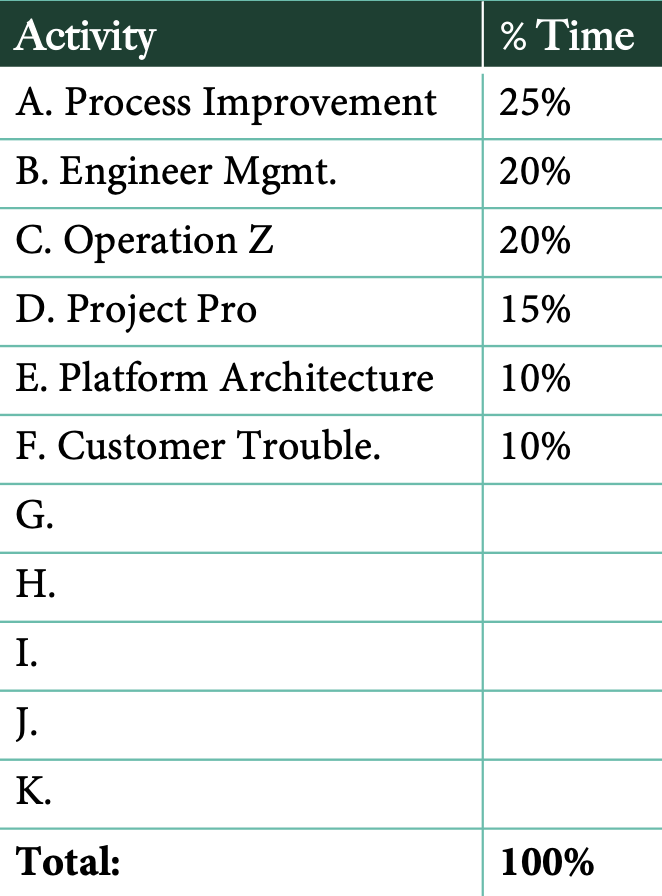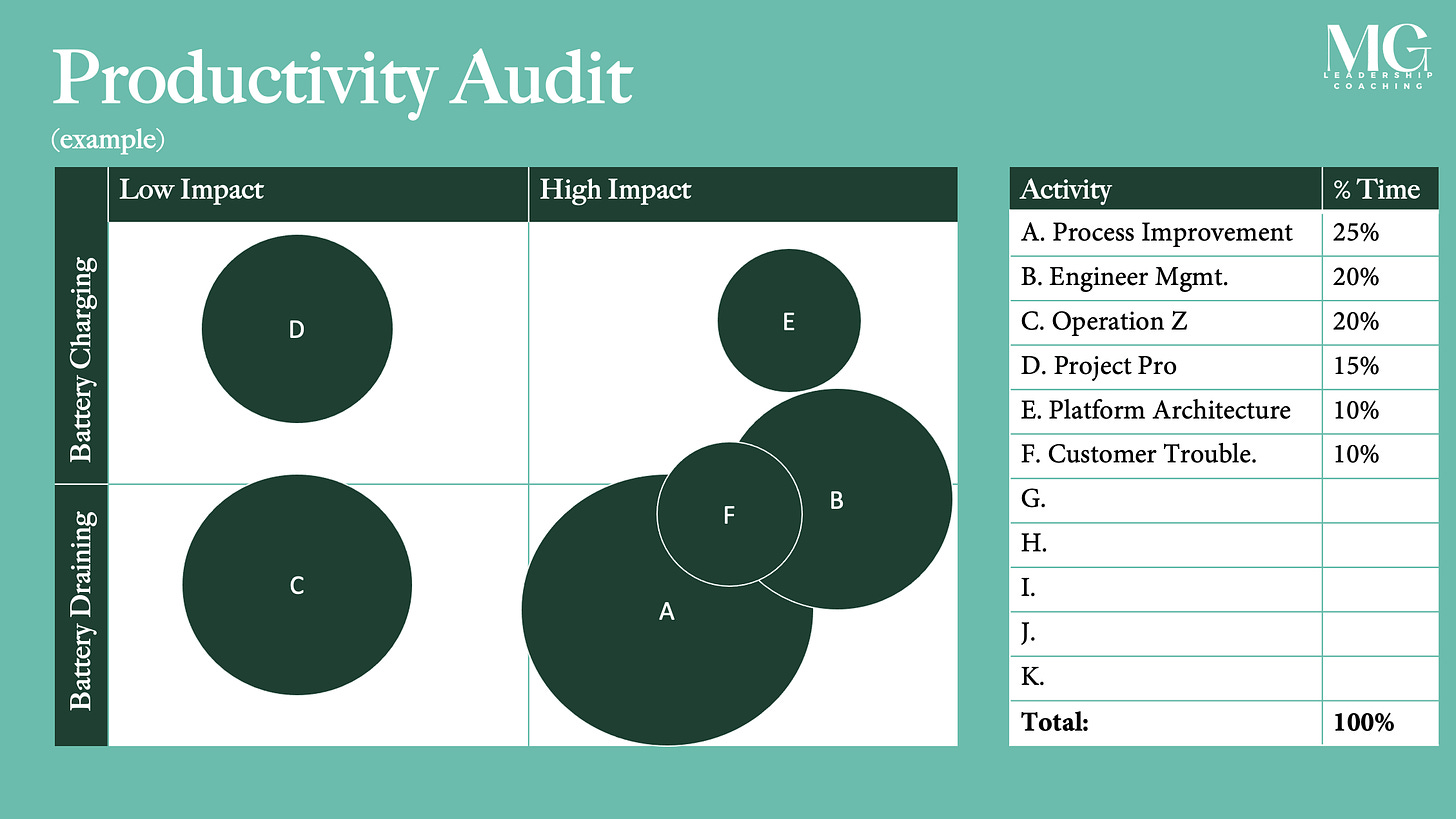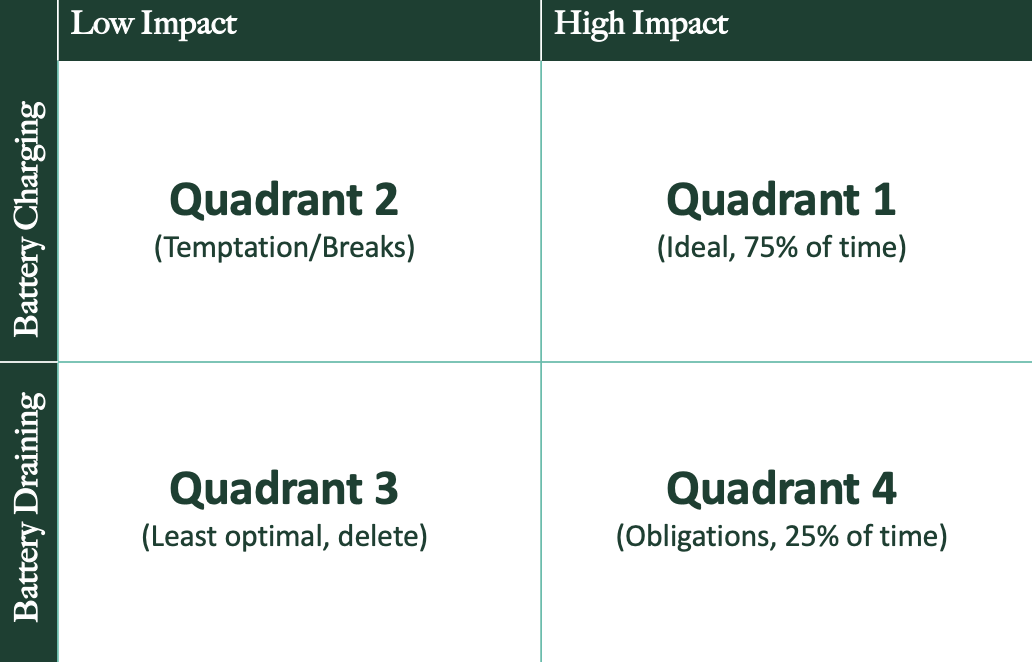The prevalence of burnout is increasingly common, with demanding work schedules and constant digital distractions leaving many feeling exhausted. While there are many factors contributing to burn out, two of the most prevalent include:
The inability to see the impact of our efforts
Engaging in energy-draining instead of energy-charging activities
Burnout perpetuates a cycle wherein decreased productivity, lengthier to-do lists, and diminished impact contribute to further burnout.
Today I want to show you a method to audit your workload so you can mitigate burnout, boost your productivity and optimize your time and energy.
How to conduct a productivity audit
I’ve uploaded a template for you to use as a guide at the bottom of this blog. Feel free to download and either print it out or complete it digitally in PowerPoint.
Step 1: List all of work activities you invest time in
Be specific. For instance, rather than listing "meetings," identify their purposes, such as management, planning, troubleshooting, or project collaboration.
Label each activity A-Z.
Step 2: Distribute your time
Evaluate the percentage of time dedicated to each activity, ensuring they sum up to 100%. Depending on your work’s variability, consider time allocation over the course of a week or month.
Step 3: Plot on the energy-impact matrix
The energy-impact matrix is a graph that gauges the impact of your work on the organization (ranging from low impact to high impact on the x-axis) against the energizing effect of the activity for you (from battery draining to battery charging on the y-axis).
To represent activities, utilize circles sized proportionally to the percentage of time spent on each task. You can find an example below.
In the downloadable PDF below, I've included pre-created circles corresponding to different percentages for you to copy and paste. Be sure to label each circle from A to Z, corresponding to the activity it represents.
Step 4: Assess the allocation of your energy and time
Analyze your time and energy distribution across quadrants: What observations can you make about the allocation of your energy and time?
Quadrant 1 (high impact, battery charging)
This quadrant is the ideal space for investing our time. To prevent burnout, aim to allocate 75% of your time to activities within this quadrant.
Quadrant 2 (low impact, battery charging)
Time spent in this quadrant often involves temptations or breaks. Examples include browsing the internet, using LinkedIn, or pursuing passion projects unrelated to your goals or scope of work. We may find ourselves in this quadrant when we spend excessive time on battery-draining activities. The objective is to minimize time spent here as much as possible.
Quadrant 3 (low impact, battery draining)
This quadrant is the least optimal for investing our time. The objective should be to avoid spending any time here and to eliminate any activities that fall into this category.
Quadrant 4 (high impact, battery draining)
This quadrant represents obligations. Often, we allocate excessive time to tasks here, leading to burnout. While we may not eliminate time in this quadrant entirely, we should aim to limit it to a maximum of 25% of our time.
Step 5: Optimize your time and energy
Now that you’ve plotted your activities on the energy-impact matrix and taken a look at how you are spending your time, it’s time to optimize!
Delegate or delete draining and low-impact activities. For tasks in quadrant 3, which are both low impact and energy-draining, consider removing them entirely. If they aren't contributing to the business and are draining your energy, they're consuming time and energy that could be better utilized elsewhere.
For tasks in quadrant 4, which are high impact but energy-draining, try identifying someone in your team who might be motivated by this activity. Can you delegate it to them or assign it as a stretch project to one of your team members?Allocate 1% of your week to planning.As the saying goes, "If you fail to plan, you plan to fail." Spending a few minutes each day or 30 minutes weekly can significantly impact our time management. Without proper planning, we often find ourselves dealing with quadrant 4 activities—reacting to crises, rather than being proactive. During your weekly planning session, reflect on how you can improve proactivity. Consider “what you need to say ‘no’ to in order to say ‘yes’ to being proactive?”.
Optimize your energy for high-impact activities. Some high-impact activities that drain your energy may be non-delegable or challenging to address proactively. For these activities, it requires a bit more introspection as we endeavor to shift them from quadrant 4 to quadrant 1.
While considering these activities ask yourself “What aspects of this task drain my energy?”Have you set unrealistic or overly high expectations for yourself, such as demanding perfection? Consider resetting your expectations.
Are you dwelling on past mistakes or failures instead of adopting a growth mindset? Practice self-empathy and focus on lessons learned.
Do you tend to concentrate more on what isn't working rather than celebrating successes? Shift your focus to small wins to avoid feeling drained and diminishing your impact.
Are you procrastinating on taking action and feeling guilty? Practice self-empathy and identify the next smallest step to get started.
Does the activity take longer than expected to complete? Ensure you're not multitasking and focus on completing one task at a time to increase productivity.
As you reflect on why the activity drains your energy, consider what could make it more energizing for you.
If collaboration energizes you, seek opportunities to partner with others on the task.
If data excites you, aim to incorporate more data-driven approaches.
If serving others fuels you, focus on the impact the activity has on their work.
If creativity inspires you, infuse creative elements into your tasks, such as brainstorming new ideas or designing visually appealing presentations.
If learning motivates you, explore avenues to expand your knowledge and skills in the area.
If organization and planning invigorate you, develop efficient systems and processes to streamline your workflow.
Quite often, simply approaching a task from a different angle can change its impact on our energy.
Coaching Challenge
Download the energy-impact matrix below and conduct your own productivity audit. Consider the following:
What observations can you make about your allocation of time and energy?
Which activities should you consider deleting or delegating?
Where do you need to allocate more time for planning?
What aspects of the activities in quadrant 4 drain your energy?
How can you make the quadrant 4 activities more energizing for yourself?
Consider implementing the productivity audit with your team. Have each member complete their own audit and then come together to fill one out collectively.
Determine which activities your team should drop due to their lack of impact.
Identify activities that drain one person but energize another.
Evaluate how to allocate more time for planning and reflection in your schedules.
Identify aspects of certain high-impact activities that are draining for the team.
Brainstorm ways to make high-impact, battery-draining activities more energizing.
To download a powerpoint version, click here.
The productivity audit isn't a one-time task; it's a tool you can repeatedly use to optimize your time, energy, and impact to the fullest potential. Consider incorporating it into your or your team's quarterly or annual review cycle.
Share your optimization experiences in the comments below!







